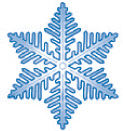It's Raining Fish and Spiders (18 page)
Read It's Raining Fish and Spiders Online
Authors: Bill Evans

Types of Snowflakes

Frank Picini
National Oceanic and Atmospheric Administration/Department of Commerce
Simple Prisms

The examples at right show two stubby prisms (left and right) and one thin plate (center). Snow crystal facets are rarely perfectly flat, being more typically decorated with various indents, ridges, or other features.

A hexagonal prism is the most basic snow crystal. Depending on how fast the different facets grow, snow crystal prisms can appear as thin hexagonal plates, slender hexagonal columns (shaped a lot like wooden pencils), or anything in between. Simple prisms are usually so small they can barely be seen with the naked eye.
Stellar Plates

These common snowflakes are thin, platelike crystals with six broad arms that form a starlike shape. Their faces are often decorated with amazingly elaborate and symmetrical markings.

Platelike snowflakes form when the temperature is near 28ºF (-2º C) or near 5ºF (-15ºC).
Sectored Plates

The simplest sectored plates are hexagonal crystals that are divided into six equal pieces, like the slices of a hexagonal pie. More complex specimens show prominent ridges on broad, flat branches.

Stellar plates often show distinctive ridges that point to the corners between adjacent prism facets. When these ridges are especially prominent, the crystals are called sectored plates.
Stellar Dendrites

Judging by holiday and winter decorations, stellar dendrites are the most popular type of snow crystal. You can see these crystals for yourself quite well with just a simple magnifier.

Dendritic means treelike, so stellar dendrites are platelike snow crystals that have branches, and sometimes, side branches. These are fairly large crystals, typically 2 to 4 mm in diameter, that can be easily seen with the naked eye.
Fernlike Stellar Dendrites

Some snowfalls contain almost nothing but stellar dendrites and fernlike stellar dendrites. It's quite a sight when they collect in vast numbers, blanketing everything in white.
Â
Sometimes the branches of stellar crystals have so many side branches they look a bit like ferns, so we call them fernlike stellar dendrites. These are the largest snow crystals, often 5 mm or more in diameter. In spite of their large size, these are single crystals of iceâthe water molecules are lined up from one end to the other.

The best powder snow, where you sink to your knees while skiing, is made of stellar dendrites. These crystals can be extremely thin and light, so they make a low-density snowpack.
Hollow Columns

Note how the two hollow regions are symmetrical in each column. Sometimes the ends grow over and enclose a pair of bubbles in the ice.

